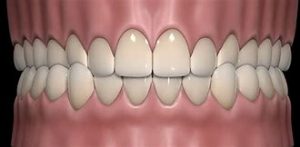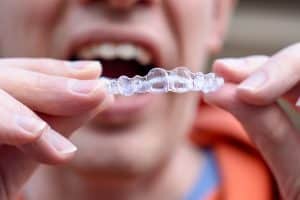In a world where our smiles communicate confidence and radiate inner beauty, dental health, and aesthetics take center stage. Your smile is a powerful statement of self-assurance, a reflection of your inner glow. It’s the universal language of confidence, and it all begins with a simple question: can Invisalign fix crossbite?
Invisalign is a technological marvel in the field of orthodontics, and people have good reason to praise it. It is an innovative alternative to traditional metal braces with wires and brackets. Clear aligners are less noticeable and more comfortable. But can Invisalign fix bite disorders, especially crossbite?
The Complexity of a Crossbite
Crossbite, a common dental misalignment, presents a multifaceted challenge that deserves our attention. It encompasses several variations, each contributing to the intricate nature of this dental issue.
Types of Crossbite
Crossbites manifest in different forms, and recognizing these variations is vital for effective diagnosis and treatment:
- Anterior Crossbite: In this scenario, the upper front teeth rest behind the lower front teeth when the jaw closes. It’s akin to your upper front teeth playing a game of hide-and-seek.
- Posterior Crossbite: In contrast, a posterior crossbite involves the upper back teeth sitting inside the lower back teeth. Picture the upper and lower back teeth as pieces of a puzzle that just don’t align correctly.
- Unilateral Crossbite: When it comes to unilateral crossbite, only one side of the mouth is affected, where either the upper or lower teeth fail to sync up properly with their counterparts on the opposite side. It’s as if a dental misalignment has chosen one side of your smile.
Underlying Causes
The origins of crossbite often involve a mix of genetic factors, irregular tooth development, or even habits formed during childhood. These causes can include:
- Genetics: Family history can play a role, as certain jaw and tooth characteristics may be inherited, increasing the likelihood of crossbite.
- Oral Habits: Prolonged thumb-sucking or pacifier use during childhood can exert pressure on the teeth and jaw, contributing to crossbite development.
- Tongue Thrusting: Habitual pushing of the tongue against the front teeth while swallowing or at rest can lead to the misalignment seen in crossbites.
- Tooth Positioning: Irregular tooth positioning or overcrowding can also contribute to the development of a crossbite.
Potential Complications
The consequences of leaving a crossbite untreated can extend beyond just aesthetics. It may lead to jaw pain, abnormal tooth wear, speech difficulties, and even impact facial development in growing children. In essence, neglecting a crossbite can set off a cascade of dental issues that affect not only your smile but also your overall oral health and well-being.
Conventional Orthodontic Approaches vs. Modern Solutions
When it comes to tackling dental issues like overbite, the world of orthodontics offers both traditional methods and innovative modern solutions. There are fundamental differences between these two approaches and reasons why more individuals are turning to contemporary alternatives like Invisalign.
Conventional Orthodontics: Traditional orthodontic techniques typically involve the use of braces, which consist of metal brackets and wires to realign teeth. Alternatively, expanders may be employed to address issues related to jaw width.
Modern Orthodontic Innovations: Recent years have witnessed the emergence of modern orthodontic options designed to provide a more discreet and comfortable path to dental correction.
Limitations of Traditional Approaches in Crossbite Correction
While traditional orthodontic methods have proven effective, they possess certain limitations when it comes to effectively treating crossbites:
- Visibility: The conspicuous appearance of braces can lead to self-consciousness, impacting self-esteem during treatment.
- Comfort Concerns: The presence of metal components can result in discomfort, oral sores, and challenges in maintaining proper dental hygiene.
- Dietary Restrictions: Traditional braces necessitate the avoidance of specific foods to prevent damage, which can be inconvenient for those with diverse dietary preferences.
- Extended Treatment Duration: Traditional orthodontic regimens often span several years before yielding desired outcomes, potentially leading to prolonged adjustment periods.
Introducing Invisalign as an Advanced and Discreet Solution
Invisalign represents a remarkable advancement in orthodontic care, harnessing cutting-edge technology to offer a discreet, comfortable, and highly effective approach to addressing crossbites:
Clear Aligners: Invisalign utilizes clear, removable aligners that are nearly invisible when worn. This allows individuals to maintain their natural appearance while undergoing treatment.
Enhanced Comfort: Crafted from smooth, BPA-free plastic, Invisalign aligners eliminate the abrasive components associated with traditional braces, reducing irritation and discomfort significantly.
Dietary Freedom: As Invisalign aligners are removable, there are no dietary restrictions during treatment. You can savor your favorite foods without worry.
Efficiency: Invisalign treatment plans often prove more efficient than traditional methods, with results becoming visible in a shorter timeframe.
Can Invisalign Fix Crossbite?
Can Invisalign fix crossbite? It’s a common question among individuals considering orthodontic treatment for their crossbite: can Invisalign really correct this complex dental issue? The answer is a resounding yes, and there’s substantial evidence to support its effectiveness.
Clinical Studies and Research
Numerous clinical studies and research findings attest to Invisalign’s ability to successfully treat crossbites. These studies have consistently demonstrated the effectiveness of Invisalign aligners in achieving crossbite correction.
For example, a study published in the “Journal of Clinical Orthodontics” examined the treatment of crossbites using Invisalign aligners. The research found that Invisalign effectively corrected crossbite in both adolescents and adults, resulting in improved dental function and aesthetics. These findings highlight the treatment’s viability across different age groups.
Can Invisalign fix crossbite? Another study, published in the “American Journal of Orthodontics and Dentofacial Orthopedics,” focused on the long-term stability of Invisalign-treated cases, including those with crossbite. The research concluded that Invisalign treatment not only effectively corrected crossbite but also maintained stable results over an extended period.
TRANSFORM YOUR SMILE WITH TRUSTED ORTHODONTICS TODAY
Whether you prefer Invisalign over braces or simply want the best for your smile, discover the difference that Smiles Orthodontics can do! Can Invisalign fix crossbite? As your premier orthodontist in Puyallup and Graham, WA, we will help you find the optimal solution for your crossbite and introduce you to the best smile you’ve ever had.
Why Choose Smiles Orthodontics?
✅ Premiere Provider of Invisalign in Puyallup and Graham, WA
✅ Personalized Patient Care for an Exceptional Experience
✅ An Awesome, Experienced Team Committed to Quality
✅ State-of-the-Art Technology for Precision Treatment
✅ Community-Focused Orthodontists Impacting Lives
It’s time to embrace the smile you deserve with the caring expertise of Dr. Bobby Virk and Dr. Helena Skountrianos. Your journey to a more radiant smile starts here! BOOK AN APPOINTMENT.




